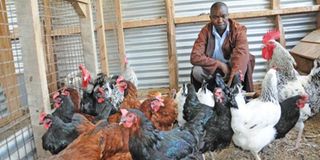Other diseases and how to prevent them

Kienyeji birds are disease tolerant. PHOTO | FILE
What you need to know:
- Vaccinations should be administered by trained personnel only. These include veterinarians and vetted animal health officers.
- By 16 weeks, chicken should be vaccinated against the following infectious diseases;
- Newcastle disease (NCD): This is a highly contagious viral disease that is known to be lethal and causes high numbers of fatalities in an outbreak.
It is imperative to adhere to strict vaccination regimes to prevent the outbreak of highly-infectious poultry diseases.
Vaccinations are crucial as they protect the birds from later exposure. The vaccine’s mode of action capitalises on developing antibodies specific to the antigens introduced into healthy birds, basically building up a defence mechanism in the body’s immune system before exposure.
Most of the vaccinations administered are prepared from infective cell cultures or infective amniotic fluids from inoculated chicken embryos.
These vaccines are administered through various routes that include eye and nose. However, we also have inactivated vaccines that are often administered subcutaneously or intramuscularly.
Vaccinations should be administered by trained personnel only. These include veterinarians and vetted animal health officers.
By 16 weeks, chicken should be vaccinated against the following infectious diseases;
Newcastle disease (NCD): This is a highly contagious viral disease that is known to be lethal and causes high numbers of fatalities in an outbreak.
The death rate has been recorded to up to 100 per cent and should be considered as a key disease to vaccinate your poultry against before any outbreak occurs. Symptoms often observed are digestive (profuse diarrhoea), respiratory (laboured breathing and watery discharge from nostrils) and nervous signs (twisting of the neck).
The incubation period averages two to six days. Due to the numerous strains of the viruses causing NCD, the severity of the disease differs from clinical symptoms and the rate of infection. The vaccination is administered via eye drops at day seven, day 21 and at eight weeks.
Gumboro: Also known as Infectious Bursal Disease (IBD), this is a highly-infectious viral disease that can cause upwards of 80 per cent mortality in infected chickens. This disease affects the bursa of Fabricius, an important organ of the immune system. The symptoms are diarrhoea, drooping appearance and vent pecking.
Marek’s disease: This is a viral disease that is also described as a form of avian cancer. The characteristic clinical sign is tumours in the nerves, eyes, kidneys, liver, lungs and skin. The affected bird will exhibit lameness, laboured breathing and paleness. This vaccination is administered intramuscularly in the neck muscles. The vaccination can be administered by day 10.
Fowl typhoid: A potentially serious bacterial disease that exhibits clinical signs that include diarrhoea, weakness and ruffled feathers. The disease is characterised by rapid spread and can cause up to a 100 per cent mortality rate. This is a disease that can be transmitted vertically from mother to egg (trans ovarian) or between flocks through contaminated manure and litter.
Live and inactivated vaccines are available and should be administered at six weeks intramuscularly. Other vaccinations should be against Infectious bronchitis and fowl pox.
Dr Muchunguh is a livestock expert




